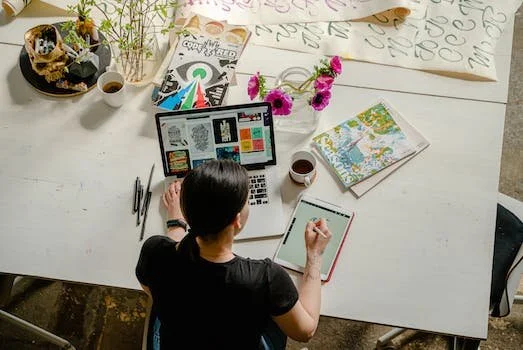The Art Behind the Screen: Exploring Digital Creativity
Introduction to Digital Creativity and its Importance
Welcome to the world of digital creativity, an exciting realm where technology meets art. This form of creativity is not just about designing attractive graphics, it's about exploring new ways of expressing thoughts, ideas, and emotions through digital formats. Digital creativity is becoming increasingly important in today's digital age, shaping how we communicate, work, learn, and entertain ourselves. It's the key to capturing attention in a world where screens are omnipresent. From website designs to social media posts, video games to virtual reality, digital creativity is at the heart of these platforms, making our interactions engaging and immersive. So, let's delve into the art behind the screen and unravel the fascinating world of digital creativity.
Understanding the Art Behind the Screen: A Closer Look at Digital Art
In our increasingly digital world, understanding the art behind the screen is crucial. Digital art is a creative expression that uses digital technology as an essential part of the creative process. It's more than just manipulating images or creating designs on a computer. It involves a deep understanding of technology, artistic principles, and the ability to bring a unique vision to life in the digital realm. Whether it's creating stunning visual effects for a movie, designing an engaging website, or producing captivating illustrations for a video game, digital art is at the heart of it. So let's dive in and explore this fascinating world of digital creativity!
The Evolution of Digital Creativity: From Pixels to 3D Modelling
The evolution of digital creativity has been truly transformative, moving from basic pixel art to complex 3D modelling. In the early days, digital artists worked with a limited palette of pixels, creating simple yet vibrant visuals. Over time, technology advanced, allowing for the creation of more detailed and realistic images. Today, 3D modelling has taken digital art to new heights. Artists can now create intricate, lifelike models that can be manipulated in a virtual space. This evolution in digital creativity has not only transformed the way we create art but also how we interact with it, opening up a whole new world of possibilities for artists and audiences alike.
Exploring Different Forms of Digital Art: Animation, Graphic Design, and more
In the realm of digital creativity, there's a plethora of artistic forms to dive into such as animation, graphic design, and more. Animation brings stories to life, with every frame meticulously crafted to create a seamless flow of movement. Graphic design, on the other hand, combines text and pictures to communicate a message effectively, often used in advertising, magazines, and books. There's also digital painting, 3D modeling, and photo editing, each requiring a unique set of skills and software. These forms of digital art have revolutionized the art world, offering limitless possibilities to artists around the globe.
The Role of Technology in Shaping Digital Creativity: Tools and Software
Technology plays a crucial role in shaping digital creativity by providing numerous tools and software that unleash the artist's potential. Various software like Adobe Creative Cloud, Procreate, Sketch, and many others have revolutionized the way we create and perceive art. These tools not only provide a platform for artists to experiment and innovate but also make art more accessible. They have broadened the scope of creativity, allowing artists to work in three-dimensions, animate their creations, and even incorporate virtual reality. Furthermore, technology enables artists to easily share their work worldwide, opening up opportunities for collaboration, feedback, and growth. Thus, technology is not just shaping digital creativity, it's redefining it.
Case Studies: Successful Examples of Digital Creativity in the Industry
In the realm of digital creativity, numerous industries have showcased successful examples through innovative case studies. For instance, Nike's "Dream Crazy" campaign, empowered by digital creativity, stirred the audience with its bold and inspiring content, resulting in increased brand recognition. Similarly, Spotify's "Wrapped" campaign utilized data-driven personalization, offering users a customized, interactive summary of their listening habits throughout the year. This approach not only increased user engagement but also created a social media buzz around the platform. These case studies underscore the power of digital creativity in transforming businesses, proving that the blend of technology and creativity can lead to remarkable success stories.
The Challenges and Opportunities in the Field of Digital Creativity
The field of digital creativity is a dynamic and evolving landscape, teeming with both challenges and opportunities. On one hand, digital artists grapple with issues like copyright infringement, steep learning curves for new software, and the constant need to upgrade equipment and skills to stay competitive. On the other hand, this field opens up a world of possibilities. The digital platform allows artists to reach a global audience, collaborate with other creatives across the world, and experiment with new mediums and techniques. Furthermore, with the rise of virtual and augmented reality, the scope for digital creativity is expanding, providing artists with an exciting playground to explore and innovate.
How to Foster and Enhance Your Digital Creativity: Tips and Techniques
Boosting digital creativity is a crucial aspect in today's tech-savvy world. Start by exposing yourself to a variety of digital platforms and tools. Familiarize yourself with graphic design, video editing, animation, and other digital art forms. Online tutorials and courses can be a valuable resource to learn and enhance your skills. Regular practice is key, as it allows you to experiment, make mistakes, and ultimately, improve. Be open to feedback and use it to refine your work. Surround yourself with inspiring digital content to stimulate your creativity. Lastly, remember that creativity is not just about technical skills, it's also about thinking outside the box and bringing unique ideas to life.
The Future of Digital Creativity: Emerging Trends and Innovations
The future of digital creativity is incredibly exciting with several emerging trends and innovations set to redefine the landscape. Virtual and augmented reality are opening up new dimensions for creative expression, allowing artists to create immersive experiences. Artificial Intelligence (AI) is also playing a significant role, not only in creating art but also in understanding and interpreting it. Furthermore, the rise of Non-Fungible Tokens (NFTs) is revolutionizing the way digital art is owned and traded, giving artists more control and opportunities to monetize their work. These advancements are pushing the boundaries of what's possible, making digital creativity more accessible and influential than ever before.
Conclusion: The Impact of Digital Creativity on Art and Society.
In conclusion, digital creativity has reshaped both art and society, creating a profound impact. It has democratized art, allowing individuals from all walks of life to create and share their work on a global scale. Digital platforms have made art more accessible, breaking down barriers of distance and cost. This has fostered a dynamic and diverse global art community, opening up opportunities for cultural exchange and mutual understanding. Additionally, digital creativity has influenced societal trends, from fashion and advertising to education and activism. As we continue to embrace technology, the influence of digital creativity on art and society will only grow stronger, shaping our world in new and exciting ways.



